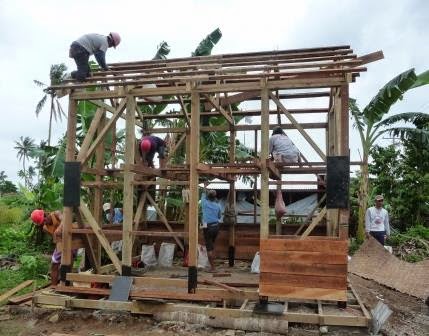If, having seen the title of this post, you are hoping to
read an existential theory about the meaning of life then I am sorry to have to
disappoint you. If, however, you are interested in what I am doing with Medair in
the Philippines then please read on.
On 8th November 2013 Super Typhoon Haiyan, known
locally as Yolanda, struck the Philippines causing widespread destruction. It
is estimated that around 6000 people were killed, a million homes were damaged
or destroyed and four million people were displaced.
Much of the initial relief effort focussed on Tacloban City,
which was home to over 200,000 people and was virtually decimated by the high
winds and the resulting storm surge (a wall of water with waves up to 25 feet
in some places). There was widespread destruction across Leyte Island and Medair
decided to work in Dulag Municipality, which is around 30 kms south of
Tacloban.
 |
| The path of Typhoon Yolanda, tracking east to west. The first place where it struck landfall is pretty much where I am right now. |
After an initial programme, which built 600 houses for the
most vulnerable in the community, we are now in the second phase which has four
main objectives:
- To build a further 1080 houses for others whose homes were completely destroyed
- To provide building materials and training to another 1200 households whose homes were severely damaged and who do not otherwise have the means to repair them
- To return to the 600 houses built in the initial phase and provide assistance, where necessary, to improve them
- To give all these households training and equipment to help them protect their homes in any future typhoon
Here are some pictures to show what the houses look like in the various stages of construction.
 |
| Laying the foundations |
 |
| The house starts to take shape |
 |
| Almost finished. Here the owner is cementing the area in front of their new home |
 |
| A mother and child - happy to show off their new home |
None of this can be done without money, staff and materials
and that is where I come in. My responsibilities are to oversee the Finance, HR
and Logistics activities of the programme. These are often the ‘hidden’
elements of any programme, but are essential to its smooth running.
- Every penny (or in this case peso) spent has to be accounted for
- We are currently employing 166 local people, half of them carpenters who are building the houses
- Sourcing, storing and transporting all the materials required to build or repair nearly 3000 homes is a significant undertaking
As the programme is scheduled to be finished by September
this year a lot of progress has already been made and I am following on with
the work done by others before me. It’s challenging, busy and diverse work,
which I’ll blog about in more detail another time.
Maybe one day I’ll also write about the meaning of life –
but I wouldn’t hold your breath waiting for that post…!
